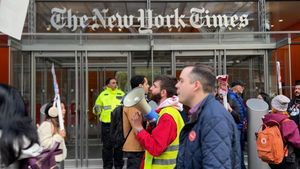Wildfires have become all too familiar and devastating scenes, especially across Northern California, where the recent Park Fire has garnered attention not just for its sheer size but its disastrous effects. Spanning over 429,000 acres, this fire has rapidly become one of California's largest ever as it threatens nearby communities and natural habitats alike.
Firefighters are currently working tirelessly to contain the blaze, which is now reported to be at 39% containment. This relentless effort to manage the fire is all the more critical as the flames continue to threaten areas such as Mill Creek and the town of Mineral.
The Park Fire, which ignited on July 24, has been fueled not only by dry conditions but also by the disturbing trend of escalating wildfire behaviors due to climate change. Witnesses have noted the fire spreading at alarming rates, at times covering 8 square miles with flames consuming everything in their path.
According to UCLA climate scientist Daniel Swain, the rapid expansion of the Park Fire is unprecedented, highlighting the increasingly extreme patterns of wildfire behavior. "I am not sure we’ve seen faster rates of spread on a modern California wildfire," he stated, reiterative of the threats posed by these natural disasters.
Firenados, or flaming tornadoes formed from extreme heat and wind interaction, are just one example of the chaotic conditions created by the Park Fire. These swirling columns of fire not only pose serious risks for firefighters but also create unpredictable fire behavior, complicate containment efforts, and create hazardous air quality for residents.
The impacts of the Park Fire extend beyond the immediate threat to life and property. With the rising frequency and intensity of wildfires, the financial expenditures for fighting these fires are immense, reportedly costing between $400 to $900 billion annually.
The 2024 wildfire season has already seen 78 active wildfires across multiple Western states, including Colorado, Wyoming, and Oregon. Despite being below the ten-year average for fire incidents, this year's uncontrolled spread and acreage burned tell another story.
A systematic approach to wildfire management has been developing; here's the catch: it's simply not effective anymore under current climate conditions. Though America has had formal wildfire management since 1876, the changing climate continues to challenge traditional strategies.
Crew turnover is high due to low pay and issues related to accessing adequate resources and equipment. Compounding the issue, prison reform has led to fewer inmates available to fight fires, reducing California's previously significant workforce for managing these disasters.
This year, the Biden administration has allocated funds—$2.5 billion—to aid fire reduction efforts. Yet, overwhelming situations like the Park Fire reveal the insufficiency of past strategies, such as those noted by the Wildfire Leadership Council, which warned, "We no longer have the luxury of waiting to see what happens."
The Park Fire's continuous threat highlights the urgent need for more effective solutions and proactive measures. It's clear: the fight against wildfires is no simple task, calling for innovation and systemic change.
Alongside the intense firefighting efforts, many Californians find themselves grappling with the practical fallout from the wildfires. Communities face evacuations, significant property losses, and long-lasting effects on their air quality.
The psychological impact of such disasters cannot be overlooked either. Residents constantly watch the skies with apprehension, anticipating the next round of infernos consuming their beloved landscapes.
Experts continually urge for improved ecological management practices, which might alleviate some of the pressures these fires create. Current methods of prescribed burning to manage forest growth and reduce risk are under scrutiny, as they simply are not being implemented effectively enough.
The complexity of wildfire management goes hand-in-hand with the pressing realities of climate change—drier conditions lead to increased fire susceptibility. Thus, innovative approaches and comprehensive plans are required, taking heed of the lessons learned from the Park Fire and its aftermath.
Firefighters, agencies, and communities alike are left with one burning question: how do they better prepare for what seems to be our new normal? The need for substantial reform is more pressing than ever.



